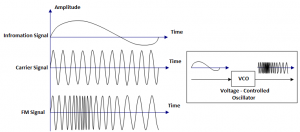Modulation
Modulation is the branch of science in electronics and communication systems including varying the fundamental properties of the basic signal by superimposing it with a carrier signal to carry the signal from one location to the other.
Modulation is the process of changing the characteristics of the carrier signal, in accordance with the amplitude of the message signal. A device that performs modulation is called as Modulation. It is the process of superimposing the information contents of a modulating signal on a carrier signal by varying the characteristic of carrier signal according to the modulating signal.

At the receiver the base signal represents by removing the carrier signal and filtering the signal to remove any unwanted noise.
Types of Signals in Modulation: Three types of signals are used to transmit information from source to destination. They are:
1. Carrier Signal: The high energy or high frequency signal which has characteristics like amplitude, frequency, and phase but contains no information is called a carrier signal. It is also simply referred to as a carrier. Carrier signal is used to carry the message signal from transmitter to receiver. The carrier signal is also sometimes referred to as an empty signal.
2. Modulated Signal: When the message signal is mixed with the carrier signal, a new signal is produced. This new signal is known as a modulated signal. The modulated signal is the combination of the carrier signal and modulating signal.
3. Message Signal: The signal which contains a message to be transmitted to the destination is called a message signal. The message signal is also known as a modulating signal or baseband signal. The original frequency range of a transmission signal is called baseband signal. The message signal or baseband signal undergoes a process called modulation before it gets transmitted over the communication channel. Hence, the message signal is also known as the modulating signal.
